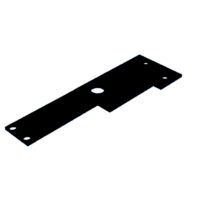Introduction: Kinetic Sculpture Flower REMIX
This remix is based on Amit_Jain's design: Kinetic-Sculpture-Flower
https://www.instructables.com/Kinetic-Sculpture-Flower/
https://cults3d.com/en/3d-model/art/kinetic-sculpture-v2-flower
I thank him for this design. I learned a lot about gears and getting two wheels to spin in opposite directions.
I actually built several versions of his sculpture, trying to make it more stable and quieter. Waisted a lot of time and plastic. In the end, I returned to his original design, but with a lot of small mods.
Noise was my main issue. I didn't want to hear the motor vibrating and the gears churning. Noise comes from three areas: (1) The motor itself. I have chosen a smaller motor that makes almost no sound. (2) The motor amplified by the plastic gear box. I've chosen to print that part of the gear box with TPU. (3) The gears rubbing against one another. I've chosen to print 3 of the gears with TPU.
I am pleased to say that my goal has been met: It is very quiet!
Supplies
- I replaced the recommended motor with a smaller, quieter one running at 28RPM.
28RPM at 5V: https://www.amazon.com/30RPM-Shaft-Metal-Gearwheel-GA12-N20/dp/B00SL1R7E2
54RPM at 5V: https://www.ebay.com/itm/323645595369
If the motor is spinning at 28RPM, the flower will spin at 4RPM. (This was my preference.)
If the motor is spinning at 54RPM, the flower will spin at 7.7RPM.
(The motor's gear has 10 teeth, and the flower's gear has 70 teeth. So the motor gear goes through 7 spins to cover one loop around the flower's 70 teeth. In 1 minute of the motor spinning at 28RPM, it has gone through 28 x 10 = 280 teeth of the motor's gear. 280 teeth/min divided by 70 teeth per revolution = 4RPM of the flower.
- Screws remain the same:
(1) M4x50
(4) M4x25
- Screw driver
- Glue: I recommend Loctite Super Glue Ultragel Control. The gel formula is best when surfaces are not absolutely flat against one another.
- 3D printer (of course)
- PLA filament
- TPU filament (optional)
- soldering iron
- wire
- The 5V motor can be driven by an ordinary USB cable and power plug. Here is what I recommend for connecting the cable:: https://www.amazon.com/gp/product/B07KS1RPMP/ The micro USB female jack comes with breakout pins. I cut off the middle 3, leaving the power and ground remaining. (It doesn't matter which wire you connect to which terminal of the motor.) Refer to my photo of how I wired the motor.
Step 1: 3D Printing the Parts
Printing the parts: No supports are required. 15% infill. 0.2 layers.
The following parts are used unchanged from the original.
You can download them from https://cults3d.com/en/3d-model/art/kinetic-sculpture-v2-flower
- 70T Gear back.stl (TPU?)
- 70 gear front.stl
- Flower front wheel.stl
- Flower back wheel.stl
- Flower 4 arms x6.stl (printed 6 times to produce 24 petals)
My modified parts:
- Back_plate_gear Box REMIX.stl
- front_plate_gear box REMIX.stl
- Motor Mount.stl (TPU?)
- 10T Gear REMIX.stl
- 20T Gears REMIX.stl (TPU?)
- Gear Stiffiner.stl
- gear spacers & hubcap.stl
Step 2: Putting It Together
While the gear box is printed in PLA, the "Motor Mount" can be printed in PLA or TPU. (The green parts are TPU.) I chose TPU because it is quieter by cutting down on the vibration of the motor against the plastic. After printing the "Back_plate_gear Box REMIX" and the "Motor Mount," snap the Motor Mount into the gear box from the top. It will be very tight (if not tight, then add glue).
All screws (except the longest one) should be put in from the front, through the gears, into the gearbox. (This differs from Amit_Jain's original graphic.)
The longer 50mm screw will still need to enter from the back towards the front. I have added a larger hole on the back of the gear box to simplify managing that screw.
All of the holes in the front plate should allow the screws to turn freely. Then, as the screws go into the back gear box, they will be quite snug. You might or might not need to apply nuts or glue to the screws inside the gear box.
When complete, only the 50mm screw should be able to turn freely.
I have chosen to print 3 or 4 of the gears from TPU to help the thing run quieter. If you, too, choose TPU, you will need to print two copies of "Gear Stiffiner.stl" and glue one onto each of the large gears (on the side with the stub). If not using TPU, then don't use "Gear Stiffiner.stl". (I had trouble printing the front large gear with TPU, so I reverted to PLA for it.
When the first (back) large gear is screwed on, you need to leave the smallest gap possible between it and the gear box - you don't want it to rub, but you don't want it to wobble. So, screw it all the way on, then back it off a half-turn. When you are certain that the gear is on the screw just far enough, and the gear and the screw - as a unit - spin freely, then you will unscrew it, put glue on the screw away from the head, and then repeat the process of tightening and loosening the gear. When gluing the gear to the screw, be careful where you put that drop of glue. You must be absolutely sure that neither the screw nor the gear ends up glued to the gear box. So, after screwing the gear to the correct position, keep slowly spinning the gear and screw (together) loosely for a while. Use super glue; airplane glue does not work well.
I have created spacers to help parts fit better. The one that is embossed with "Between Large Gears" should be glued to the back of the large gear that has the longer hub.
Regarding the 2 20-tooth gears that look the same: They are a bit different from one another. The numbers "1" and "2' are carved into them. The #1 gear is the outer-most and will be mounted with the hub facing forward. The #2 gear will be mounted with the hub facing towards the back. These 2 gears need to spin freely, but the screws they are on must not turn! As the gears turn, they will have a tendancy to turn the screws, which will cause them to tighten up. You have to find a way to prevent these 2 screws from moving, once you have them property adjusted. Glue the screw to the gear box. If you are printing with TPU, you might have to drill out their center holes with a 3/16" drill bit to allow the gear to spin freely on the screw.
As you tighten the 4 corner screws into the gear box cover, you will be pulling the cover closer to the gears. You want to leave a slight gap between that cover and the gears. You don't want things rubbing against one another.
Before installing the motor and its gear into the gear box, first make sure that all of the gears turn freely. Turning any one of the gears should make all the other gears turn easily. Probably the most difficult task will be the balancing of the screws, securing the ones that are not supposed to turn, and keeping the one long one that is supposed to turn.
Motor Mount: Make sure that the hub of the small gear (which will go onto the motor) can spin easily in its hole on the front of the gear box (I had to carve it a little larger). Clean the inside of the "Motor Mount" very well. Also clean inside the gear box where the Motor Mount will be placed. (Fitting will be very tight.) Then insert the "Motor Mount.stl" piece into the gear box. I have created this separately so that you can choose whether to print with PLA or TPU. TPU will eliminate a lot of the noise that the motor makes when set against the plastic gear box. You might need to glue this into place (if you use glue, use a tiny amount, in case you need to remove it for adjustments).
Motor: Solder two wires onto the motor. Then slide the motor into the Motor Mount (which is already inside the gear box) through the square hole on the back (it will be tight). The motor's rotor should be centered in the hole. Then mount the small gear. Later when you connect the wires to the micro USB female jack, swapping the wires results in the wheels turning in the other direction.
After the "front_plate_gear box REMIX" is screwed into place, the remaining pieces are applied in the following order: (1) "back spacer" (2) flower with the larger hole. [When all is completed, remove the front flower and put a drop of glue on the back flower and the large axle.] (3) "middle spacer" (4) flower with the smaller hole, pointing in the opposite direction from the rear flower. This gets screwed on. YOU MUST put a screw driver against the head of the long screw to ensure that it does not turn while you are installing this front flower. (5) The "hub cap" goes on last, simply to make things look cleaner. (Again, be sure to use a screw driver to keep the long screw from turning.) [When all is completed, glue the front flower to its screw axle.]
If it runs well for 30 seconds, then go back and glue the two flowers to their axles because the spinning action can cause them to tighten or loosen - which would not be good.
Glue the micro USB female jack inside the gear box, connect the two wires from the motor, and run a USB cable to the jack. (Look at the photo.)
NOTE: If everything works at first but then stops, it's most probably because 1 or more of the 3 gear screws have caused the gears to tighten up. Figure out which gear it is, and re-glue it.
I hope you have fun building this. You need to think through each step when putting it together, especially about how easy each part should move.

















